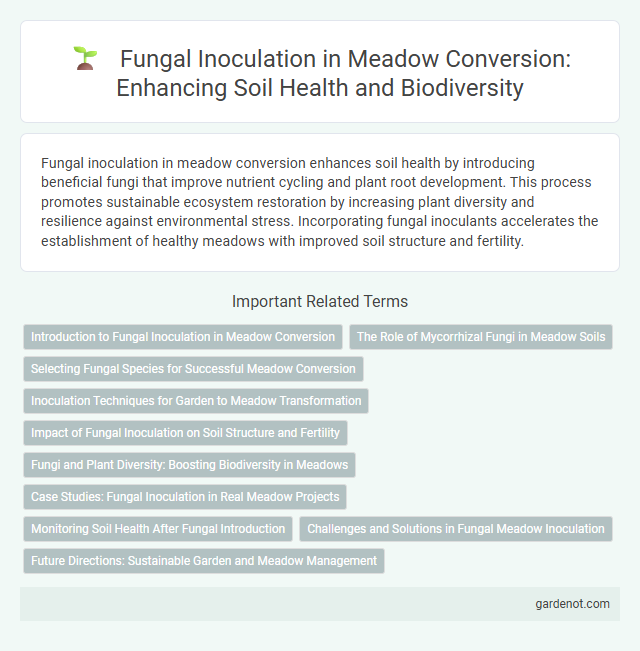Fungal inoculation in meadow conversion enhances soil health by introducing beneficial fungi that improve nutrient cycling and plant root development. This process promotes sustainable ecosystem restoration by increasing plant diversity and resilience against environmental stress. Incorporating fungal inoculants accelerates the establishment of healthy meadows with improved soil structure and fertility.
Introduction to Fungal Inoculation in Meadow Conversion
Fungal inoculation plays a crucial role in meadow conversion by enhancing soil health and promoting nutrient cycling through mycorrhizal networks. Introducing specific fungal species during the restoration process improves plant root structure and increases water retention, leading to more resilient and biodiverse meadow ecosystems. This technique accelerates the establishment of native vegetation and supports long-term ecological stability in converted meadows.
The Role of Mycorrhizal Fungi in Meadow Soils
Mycorrhizal fungi form symbiotic relationships with meadow plant roots, significantly enhancing nutrient uptake, especially phosphorus and nitrogen, critical for plant growth and soil health. These fungi improve soil structure by promoting aggregation, which increases water retention and aeration, essential for meadow ecosystem resilience. Inoculating meadow soils with mycorrhizal fungi accelerates plant establishment and biodiversity, supporting sustainable meadow restoration and long-term ecological balance.
Selecting Fungal Species for Successful Meadow Conversion
Selecting fungal species for successful meadow conversion requires prioritizing mycorrhizal fungi that form symbiotic relationships with native meadow plants, enhancing nutrient uptake and soil health. Arbuscular mycorrhizal fungi (AMF) and certain ectomycorrhizal species are commonly chosen due to their proven efficacy in supporting plant establishment and resilience. Accurate matching of fungal species with target plant communities and soil conditions optimizes ecosystem restoration and promotes long-term meadow stability.
Inoculation Techniques for Garden to Meadow Transformation
Fungal inoculation plays a critical role in garden to meadow transformation by enhancing soil health and promoting native plant growth. Techniques such as spore slurry application, mycorrhizal spore embedding in soil, and the use of fungal-inoculated mulch optimize the symbiotic relationships between fungi and meadow vegetation. These methods improve nutrient cycling, water retention, and plant resilience, accelerating the establishment of diverse meadow ecosystems.
Impact of Fungal Inoculation on Soil Structure and Fertility
Fungal inoculation enhances soil structure by promoting the formation of stable soil aggregates through the growth of fungal hyphae, which bind soil particles together. This improved soil architecture increases porosity and water retention, facilitating better root penetration and nutrient uptake. Additionally, mycorrhizal fungi contribute to soil fertility by enhancing nutrient cycling and increasing the bioavailability of essential minerals such as phosphorus and nitrogen.
Fungi and Plant Diversity: Boosting Biodiversity in Meadows
Fungal inoculation introduces mycorrhizal fungi that form symbiotic relationships with meadow plants, enhancing nutrient uptake and plant health. This symbiosis supports greater plant diversity by improving soil structure and fertility, creating a resilient ecosystem. Increased fungal diversity in inoculated meadows promotes a stable habitat that sustains diverse flora and associated wildlife.
Case Studies: Fungal Inoculation in Real Meadow Projects
Case studies on fungal inoculation in meadow restoration projects reveal significant improvements in soil health and plant diversity. Inoculation with mycorrhizal fungi enhanced nutrient uptake and increased native grass establishment across multiple sites in the Pacific Northwest and Midwest regions. Long-term monitoring demonstrated higher ecosystem resilience and reduced dependence on chemical fertilizers, highlighting the efficacy of fungal inoculation in sustainable meadow management.
Monitoring Soil Health After Fungal Introduction
Monitoring soil health after fungal inoculation in meadow conversion involves regularly assessing microbial biomass, nutrient cycling rates, and soil respiration to gauge ecosystem recovery. Soil enzyme activity and changes in fungal community composition provide critical indicators of successful symbiosis and nutrient mineralization. Utilizing DNA sequencing and soil chemistry analyses ensures precise tracking of fungal colonization impact on soil structure and fertility.
Challenges and Solutions in Fungal Meadow Inoculation
Fungal inoculation in meadow conversion faces significant challenges such as ensuring the compatibility of fungal species with native plants and maintaining fungal viability during application. Effective solutions include selecting region-specific mycorrhizal fungi and employing controlled inoculum delivery methods like granular formulations or root dips to enhance colonization success. Monitoring soil conditions and adjusting inoculation timing further improve fungal establishment and meadow ecosystem resilience.
Future Directions: Sustainable Garden and Meadow Management
Fungal inoculation in meadow conversion enhances soil health by promoting mycorrhizal networks that improve nutrient uptake and plant resilience. Future sustainable garden and meadow management will prioritize integrating diverse fungal species to support ecosystem services, such as carbon sequestration and drought resistance. Ongoing research aims to optimize fungal strains for different soil types, advancing long-term biodiversity and productivity in restored meadows.
Fungal inoculation Infographic

 gardenot.com
gardenot.com